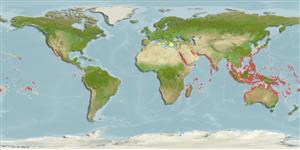Common names from other countries
Environment: milieu / climate zone / depth range / distribution range
Écologie
; profondeur 0 - 20 m (Ref. 348). Tropical
Distribution
Pays | Zones FAO | Écosystèmes | Occurrences | Introductions
Indo-West Pacific and the Mediterranean: from East Africa, to Melanesia; north to South China and Taiwan Province of China and south to Indonesia; south and eastern parts of the Mediterranean. Tropical to subtropical climates.
Length at first maturity / Taille / Poids / Âge
Maturity: Lm ? range ? - ? cm Max length : 12.0 cm SHL mâle / non sexé; (Ref. 348); common length : 8.0 cm mâle / non sexé; (Ref. 348)
Locally collected at low tide by coastal people when abundant (Ref. 348).
Life cycle and mating behavior
Maturité | Reproduction | Frai | Œufs | Fécondité | Larves
Members of the class Bivalvia are mostly gonochoric, some are protandric hermaphrodites. Life cycle: Embryos develop into free-swimming trocophore larvae, succeeded by the bivalve veliger, resembling a miniature clam.
Poutiers, J.M. 1998. (Ref. 348)
Statut dans la liste rouge de l'IUCN (Ref. 130435: Version 2024-1)
statut CITES (Ref. 108899)
Not Evaluated
Not Evaluated
Utilisations par l'homme
| FishSource |
Outils
Plus d'informations
Taille/Âge
Croissance
Longueur-poids
Longueur-longueur
Morphologie
Larves
Abondance
Sources Internet
Estimates based on models
Preferred temperature
(Ref.
115969): 22.1 - 29.3, mean 28.2 (based on 4092 cells).
Vulnérabilité
Low vulnerability (10 of 100).
Catégorie de prix
Unknown.
